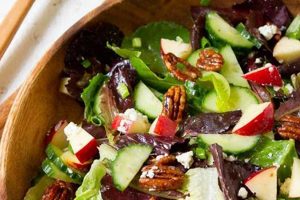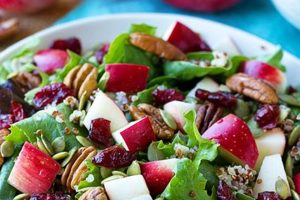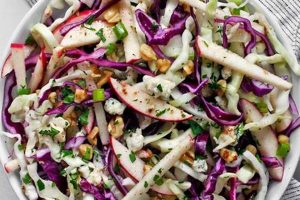A dish featuring thinly sliced fennel and apple, this culinary creation often incorporates complementary ingredients such as citrus fruits, herbs, nuts, cheese, and a light vinaigrette. Variations can include dried fruits like raisins or cranberries, and diverse cheeses, ranging from Parmesan to blue cheese. A simple example might combine crisp apple slices, shaved fennel bulb, toasted walnuts, crumbled blue cheese, and a lemon-vinaigrette.
The combination of apple and fennel offers a refreshing and flavorful contrast. Fennel’s subtle anise flavor complements the sweetness of apples, creating a balanced flavor profile. The dish is typically light and refreshing, making it an ideal appetizer, side dish, or component in a larger meal. From a nutritional standpoint, this type of salad provides vitamins, minerals, and fiber, contributing to a healthy diet. While its precise origin is difficult to pinpoint, the combination likely emerged as cooks experimented with seasonal ingredients and complementary flavor pairings.
This exploration will delve further into variations, ingredient selection, preparation techniques, and serving suggestions for maximizing enjoyment of dishes based on this refreshing pairing. Detailed recipes and guidance will empower readers to confidently create their own variations.
Tips for a Perfect Apple Fennel Salad
Creating a balanced and flavorful salad hinges on proper ingredient selection and preparation. These tips offer guidance for achieving optimal results.
Tip 1: Choose Crisp Apples: Opt for firm, tart varieties like Honeycrisp, Fuji, or Granny Smith. These maintain their texture and provide a pleasant contrast to the fennel’s anise notes. Avoid overly ripe or mealy apples.
Tip 2: Slice Ingredients Thinly: Thinly slicing both the fennel bulb and apple ensures a delicate texture and allows the flavors to meld effectively. A mandoline slicer or sharp knife is recommended.
Tip 3: Prevent Browning: Tossing sliced apples with a bit of lemon juice helps prevent oxidation and maintains their appealing appearance.
Tip 4: Balance Flavors with Acidity: Incorporating citrus juice (lemon, orange, or grapefruit) into the dressing provides a necessary acidic counterpoint to the sweetness of the apple and the subtle anise of the fennel.
Tip 5: Add Textural Contrast: Toasted nuts, such as walnuts, pecans, or almonds, provide a satisfying crunch. Seeds, like sunflower or pumpkin, offer a similar benefit.
Tip 6: Consider Cheese: Crumbled blue cheese, feta, or shaved Parmesan can add a salty, savory dimension. Select a cheese that complements the other flavors.
Tip 7: Dress Lightly: A light vinaigrette is ideal. Overdressing can mask the delicate flavors of the apple and fennel.
Tip 8: Serve Promptly: This type of salad is best enjoyed fresh. While some components can be prepared in advance, it’s recommended to combine and dress the salad just before serving to maintain optimal texture and prevent the ingredients from becoming soggy.
By following these tips, one can create a visually appealing and flavorful salad that highlights the complementary characteristics of apple and fennel. Careful attention to detail ensures a truly satisfying culinary experience.
The following section offers specific recipe examples, incorporating these principles to guide culinary exploration.
1. Ingredients
Ingredient selection significantly impacts the overall flavor profile and textural complexity of an apple fennel salad. Careful consideration of each component ensures a balanced and satisfying culinary experience. Understanding the role of each ingredient allows for informed substitutions and creative variations.
- Apples
Apples provide the foundational sweetness and contribute to the salad’s refreshing character. Tart varieties like Granny Smith or Braeburn offer a crisp texture and a sharp flavor that balances the fennel’s anise notes. Sweeter options, such as Honeycrisp or Fuji, lend a milder sweetness and a juicier texture. The choice of apple influences the overall balance and complexity of the salad.
- Fennel
Fennel, with its distinctive anise flavor, provides a subtle licorice note that complements the apple’s sweetness. Both the bulb and the fronds are utilized; the bulb offers a crisp, slightly crunchy texture, while the fronds provide a delicate, feathery garnish and a more pronounced anise flavor. Freshness is crucial; selecting firm bulbs with vibrant green fronds ensures optimal flavor and texture.
- Acids
Acidity is essential to balance the sweetness of the apple and the subtle anise of the fennel. Citrus juices, such as lemon, lime, or orange, are commonly used in the vinaigrette or as a direct addition to the salad. Vinegars, like apple cider or white wine vinegar, also provide acidity and contribute to the overall flavor profile. Balancing acidity prevents the salad from being overly sweet and enhances the other flavors.
- Textural Elements
Nuts and seeds add a contrasting textural element, providing a satisfying crunch. Walnuts, pecans, or toasted almonds complement the other flavors, while sunflower or pumpkin seeds offer a lighter, nuttier crunch. These additions prevent the salad from becoming one-dimensional in texture.
The interplay of these ingredients contributes to a successful apple fennel salad. The right balance of sweet and savory, crisp and crunchy, ensures a harmonious blend of flavors and textures. Thoughtful ingredient selection elevates the dish from a simple combination of produce to a complex and satisfying culinary creation.
2. Preparation
Preparation significantly impacts the final quality of an apple fennel salad. Proper techniques enhance both flavor and texture, while also contributing to the overall aesthetic appeal. Neglecting essential preparation steps can result in a less satisfying dish, highlighting the crucial link between preparation and the desired outcome.
Consider the impact of slicing. Thinly slicing the fennel bulb and apple creates a delicate texture and exposes more surface area, allowing the flavors to meld and the dressing to coat evenly. Conversely, thick, uneven slices result in a less refined texture and potentially uneven flavor distribution. Similarly, the timing of dressing application is critical. Dressing the salad too far in advance can lead to a soggy texture, as the acidic components in the dressing break down the cell walls of the produce. Therefore, dressing the salad just before serving preserves the crispness of the ingredients.
Another example lies in preventing enzymatic browning of the apple slices. Exposure to air triggers oxidation, causing the apple to brown and potentially develop an off-flavor. Tossing the apple slices with a small amount of acid, such as lemon juice, inhibits this process, preserving the apple’s fresh appearance and flavor. These illustrative examples underscore the direct relationship between careful preparation and a successful apple fennel salad. Proper technique optimizes the flavors and textures, ultimately elevating the culinary experience.
In summary, preparation is not merely a procedural step but rather a fundamental element in crafting a high-quality apple fennel salad. Attention to detail, from the precision of slicing to the timing of dressing application, demonstrably affects the final product. Understanding and implementing proper preparation techniques ensures a visually appealing and flavorful dish, maximizing the enjoyment of this refreshing and flavorful combination. This careful approach transforms simple ingredients into a culinary creation that delights the palate and satisfies the senses.
3. Flavor Balance
Flavor balance is paramount in an apple fennel salad recipe, impacting overall palatability. The interplay of sweet, tart, savory, and anise notes determines the final complexity and satisfaction derived from the dish. Understanding these interacting flavor components enables informed ingredient selection and adjustments to achieve a harmonious result.
- Sweetness
The apple provides the primary sweetness. The level of sweetness depends on the apple variety. Honeycrisp offers a robust sweetness, while Granny Smith provides a tart contrast. Balancing this sweetness with other flavor components is crucial to prevent an overly sugary profile.
- Acidity
Acidity counterbalances the sweetness of the apple and the anise notes of the fennel. Citrus juices, such as lemon or lime, or vinegars introduce tartness, brightening the overall flavor and preventing the salad from being cloying. The level of acidity should be carefully calibrated to complement, not overpower, the other flavors.
- Savory Notes
Savory elements add depth and complexity. Cheese, such as crumbled blue cheese or shaved Parmesan, introduces salty, umami notes. Nuts, like toasted walnuts or pecans, contribute earthy, savory flavors. These elements prevent the salad from being one-dimensionally sweet and add a satisfying richness.
- Anise Influence
Fennel’s distinct anise flavor provides a subtle licorice note. This characteristic flavor can be prominent or subdued depending on the quantity of fennel used and whether both the bulb and fronds are incorporated. Careful balancing ensures the anise complements, rather than dominates, the overall flavor profile. Too much anise can create an overpowering, medicinal taste.
The interplay of these four flavor dimensions defines the final taste experience of an apple fennel salad. A successful recipe achieves harmony among these elements. The sweetness of the apple is tempered by acidity, while savory notes and the subtle anise of the fennel contribute depth and complexity. A well-balanced apple fennel salad offers a refreshing and nuanced flavor profile, demonstrating the importance of thoughtful ingredient selection and careful balancing of contrasting tastes. This nuanced interplay elevates the dish from a simple salad to a more sophisticated and satisfying culinary creation.
4. Texture
Texture plays a crucial role in the overall enjoyment of an apple fennel salad recipe. The interplay of crisp, crunchy, and tender elements contributes to a more satisfying sensory experience. A successful salad engages multiple textural dimensions, creating a dynamic and appealing contrast that elevates the dish beyond a simple combination of ingredients. Understanding and manipulating these textural components is essential for crafting a well-balanced and enjoyable salad.
- Crispness of Apples and Fennel
The inherent crispness of fresh apples and fennel provides the foundational textural element. Proper slicing techniques maintain this crispness, ensuring a refreshing bite. Loss of crispness, often due to overdressing or delayed serving, detracts significantly from the desired textural experience. Maintaining the inherent crispness of these primary ingredients is paramount.
- Crunchy Additions
Incorporating crunchy elements provides a contrasting texture that complements the crispness of the apple and fennel. Nuts, such as toasted walnuts, almonds, or pecans, offer a satisfying crunch. Seeds, like sunflower or pumpkin seeds, introduce a lighter, nuttier crunch. These additions create textural variety, preventing the salad from becoming one-dimensionally crisp.
- Tender Elements
Softer, more tender textures can further enhance the textural complexity. Dried fruits, such as cranberries or raisins, introduce a chewy element. Crumbled cheese, like blue cheese or feta, adds a creamy, slightly yielding texture. These additions create a more nuanced and balanced textural profile.
- Dressing Influence
The dressing itself can impact texture. A light vinaigrette maintains the crispness of the ingredients, while a heavier, creamier dressing might soften them over time. The choice of dressing should align with the desired textural outcome, considering how it interacts with the other components.
The interplay of these textural elements elevates the apple fennel salad beyond a simple combination of ingredients. A well-executed salad offers a dynamic range of texturescrisp, crunchy, tendercreating a more engaging and satisfying culinary experience. Attention to texture, alongside flavor balance and ingredient selection, transforms the dish into a more sophisticated and enjoyable culinary creation.
5. Presentation
Presentation significantly influences the perceived appeal and enjoyment of an apple fennel salad recipe. While flavor and texture remain paramount, visual appeal enhances the dining experience. Thoughtful presentation elevates the dish from a simple combination of ingredients to a visually engaging culinary creation. Understanding the impact of visual elements allows for a more considered and impactful presentation, maximizing the overall enjoyment of the salad.
- Plating
Plating choices directly impact visual appeal. A simple, elegant white plate provides a neutral backdrop that allows the vibrant colors of the salad to stand out. Alternatively, a rustic wooden bowl can create a more informal, natural presentation. The size and shape of the serving vessel should complement the salad’s volume and composition. Overcrowding a plate diminishes visual appeal, while a sparsely filled plate can appear underwhelming.
- Arrangement of Ingredients
The arrangement of ingredients contributes significantly to the visual appeal. Rather than simply tossing all ingredients together, a more deliberate arrangement can create a visually striking presentation. Consider arranging the apple slices and fennel shavings in an alternating pattern or creating a layered effect. Incorporating height and dimension adds visual interest. A mound of salad in the center of the plate or a layered presentation in a clear glass bowl can enhance visual appeal.
- Garnishing
Garnishes provide finishing touches that enhance visual appeal and can complement the flavor profile. Fresh fennel fronds offer a delicate, feathery garnish that reinforces the anise notes. A sprinkle of chopped nuts or a scattering of pomegranate seeds adds color and textural contrast. A drizzle of high-quality olive oil or a sprinkle of freshly cracked black pepper adds visual interest and subtle flavor enhancements. Garnishes should be used judiciously to avoid overwhelming the main components of the salad.
- Color Contrast
Color contrast plays a significant role in visual appeal. The vibrant green of fennel, combined with the varying hues of apples, from pale yellow to deep red, creates an inherently appealing color palette. Adding ingredients with contrasting colors, such as bright orange segments of citrus fruits or deep purple radicchio, further enhances visual interest. A monochromatic color scheme can also be effective, emphasizing the subtle variations in color within the chosen palette.
These elements of presentation work in concert to create a visually appealing and engaging apple fennel salad. Careful consideration of plating, arrangement, garnishing, and color contrast elevates the dining experience. While taste and texture remain essential, thoughtful presentation maximizes enjoyment, transforming a simple salad into a visually stunning and appetizing culinary creation.
6. Dietary Considerations
Dietary considerations are integral to recipe adaptation and inclusivity, particularly concerning an apple fennel salad. This dish, inherently adaptable, offers a foundation for accommodating diverse dietary needs. Understanding these considerations allows for modifications without compromising flavor or texture, expanding accessibility for individuals with specific dietary restrictions.
Several key dietary considerations intersect with this recipe. Veganism requires the exclusion of animal products. Traditional recipes sometimes incorporate honey in the dressing; substituting agave or maple syrup provides equivalent sweetness while maintaining vegan integrity. Gluten-free diets necessitate avoiding gluten-containing ingredients. While the core recipe is typically gluten-free, care must be taken with additions like croutons or certain dressings. Opting for gluten-free bread or omitting croutons altogether ensures compliance. Dairy-free requirements necessitate omitting cheese. Nutritional yeast can provide a cheesy flavor alternative when needed. For those managing nut allergies, substituting seeds like sunflower or pumpkin seeds for nuts maintains textural contrast while ensuring safety. Individuals with fructose intolerance may need to limit or avoid apples altogether; alternative low-fructose fruits can offer a suitable replacement, though the flavor profile will inevitably shift.
Practical application of these dietary considerations requires informed substitutions and ingredient awareness. Substituting specific ingredients based on individual needs demonstrates inclusivity and expands accessibility to the dish. For example, replacing honey with maple syrup provides a readily available, vegan-friendly alternative. Understanding ingredient composition and potential cross-contamination risks is vital, particularly regarding allergies. Proper labeling and ingredient sourcing become essential for maintaining dietary compliance. Ultimately, addressing dietary considerations broadens the recipe’s appeal, ensuring enjoyment for a wider audience without compromising its fundamental flavors and textures. Adaptability and awareness in recipe preparation demonstrate a commitment to inclusive culinary practices.
Frequently Asked Questions
This section addresses common inquiries regarding apple fennel salad preparation and variations, offering practical guidance for achieving optimal results. Clarifying these points empowers individuals to confidently create and enjoy this refreshing dish.
Question 1: Can this salad be prepared in advance?
While some components, such as toasting nuts or preparing the dressing, can be done ahead of time, combining all ingredients is best done immediately before serving. This prevents the apples from browning and the fennel from becoming soggy, preserving optimal texture and flavor.
Question 2: What apple varieties are best suited for this salad?
Crisp, tart apples like Granny Smith, Braeburn, or Fuji provide a desirable textural and flavor contrast to the fennel. Sweeter varieties like Honeycrisp can also be used, but offer a different flavor profile.
Question 3: How can browning of the apple slices be prevented?
Tossing the apple slices with a small amount of lemon juice or another acidic ingredient helps prevent oxidation and maintains their fresh appearance.
Question 4: What can be substituted for fennel if it’s unavailable?
While no perfect substitute captures fennel’s unique anise flavor, celery or thinly sliced jicama can provide a similar textural element. A small amount of anise seed added to the dressing can partially replicate the flavor.
Question 5: Can different cheeses be used in this salad?
Yes, various cheeses complement this salad. Blue cheese offers a pungent, salty contrast, while feta provides a tangy, creamy element. Shaved Parmesan adds a nutty, savory dimension. The choice of cheese should complement the other flavor components.
Question 6: How should the salad be stored if there are leftovers?
Storing leftovers is not generally recommended, as the texture and flavor degrade quickly. If necessary, store any remaining salad in an airtight container in the refrigerator for no more than 24 hours. Expect some loss of crispness.
Understanding these key aspects of preparation and ingredient selection ensures consistent, high-quality results. This information empowers culinary exploration and facilitates confident adaptation to individual preferences.
The subsequent section offers specific recipe variations, demonstrating the practical application of these principles and providing concrete examples for creating delicious apple fennel salads.
Conclusion
Exploration of apple fennel salad recipes reveals a dish offering nuanced flavor profiles and textural complexity. Careful ingredient selection, precise preparation techniques, and attention to flavor balance are essential for successful outcomes. Acidity, savory notes, and textural contrasts complement the sweetness of apples and the subtle anise of fennel. Adaptability to diverse dietary needs further expands the recipe’s versatility.
Culinary experimentation with variations, informed by the principles outlined herein, promises rewarding culinary experiences. Continued exploration of flavor combinations and presentations offers potential for further development and appreciation of this refreshing and adaptable dish.






